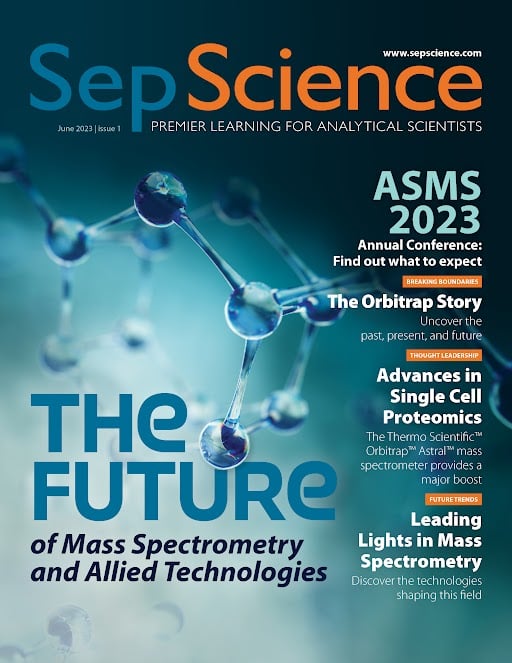This mainstay technology continues to shape the field of analytical chemistry.

Mass spectrometry has played a pivotal role in the evolution of analytical chemistry, enabling researchers to identify and quantify molecules with extreme precision and sensitivity. Among the various types of mass spectrometers, OrbitrapTM technology has emerged as one of the most powerful and versatile platforms for chemical analysis.
The basic principle of the Orbitrap analyzer is to trap ions in a hyper-conical electrode assembly and measure their mass-to-charge ratio by detecting their oscillation frequency in an electrostatic field. The high mass resolution and accuracy of Orbitrap technology have revolutionized analysis in various areas, including proteomics, clinical research, forensic technology, and environmental analysis.
The origin and evolution of Orbitrap technology
The development of the first iteration of the Orbitrap mass analyzer began in 1996, driven by a team inspired and led by Alexander Makarov, who is now Director of Global Research LSMS at Thermo Fisher Scientific. Makarov had just left his postdoc position at Warwick University. "I started my first and only job in a small startup, HD Technologies," he recounts. "I moved with my family to Manchester, and we started our journey."
Makarov was joining a small group of scientists who had accepted voluntary redundancy from the company that is now Shimadzu. The promise of their technology was evident from the beginning, with the team beating more than 180 competitors to secure an initial funding grant of £50,000 from the Department of Trade and Industry. "We won because, essentially, I was able to prepare the very first picture and the very first promise of what was later called Orbitrap based on my previous post-graduate work," explains Makarov. "Of course, it was a completely different design than what eventually reached the market."
Makarov admits that when starting out, he barely knew the difference between peptides and proteins. "But we desperately wanted to do something great—in a small company, you either run at maximum speed just to keep afloat, or you do something unusual." Ultimately, it was the company's time of flight (TOF) technology that led to its acquisition by Thermo Electron (now Thermo Fisher Scientific) in 2000, but the Orbitrap project sweetened the deal. "Our company was mainly doing time of flight for different sources—electron input source, electrospray source, MALDI, and so on—but the Orbitrap analyzer was the icing on the cake." While nobody really knew if the technology would take off, it was garnering a lot of interest.
The period between project inception and market launch was not all smooth-sailing. Although exciting, this was also a worrying time for the development team as there were questions around scalability. "If we had too many orders of LTQ Orbitrap instruments, there were concerns we couldn't ship LTQ FT anymore. But how do you ship so many instruments if you've never produced them before?" There were also challenges with the various unprecedented aspects of the Orbitrap analyzer. "For example, we had an unusual combination of voltages, and everything was compressed over a length of eight centimeters. A pressure drop of eight orders of magnitude over eight centimeters was something that was never realized before. And then there were technologies for thermal stabilization which were never tried."
Some of these components only started working months before the launch. Makarov remarks that the team got lucky but admits there was a lot of work behind the scenes to ensure the instruments were shipped and that customers were happy with the results. "This combination of high resolution and mass accuracy with very high sensitivity was essentially unparalleled," reveals Makarov. "And it was orders of magnitude more sensitive for this type of resolution than any previous instrument. This drove Orbitrap applications, and even now, this high transmission from the front-end optics to the C-trap, then from the C-trap into the Orbitrap analyzer to the detected signal is really what determines the acceptance of Orbitrap mass spectrometry in so many different fields."
One aspect of the development process that helped overcome challenges was Makarov's special effort to over-engineer the initial Orbitrap backend of the LTQ Orbitrap instrument. "Whenever I had doubts, for example, whether or not the wall was too thin, I would rather go for more," he explains. "If I didn't know what amplitude of voltage I needed, I went for reserves just in case." He adds that from there, the instruments were optimized, with feedback from the field providing valuable guidance.
Makarov notes that another key driver of success was the team itself. "The team was very small, with a core of five people," says Makarov. "Most of us were completely new to the company, so we had to prove ourselves. It wasn't just a job for money—it was a matter of our reputation and our entire standing future in the company—so everybody was highly engaged." He notes that although they didn't have time to talk much, discussions during the odd team lunch often revealed something that needed to be urgently addressed. "Eduard (Denisov) would mention that something wasn't quite working properly. What seemed like a small problem on the surface would often turn out to be something completely unexpected. And then we had to change course and repair things on the fly."
Eventually, by 2005, the instrument was brought to market. Makarov describes the classic imposter syndrome he felt during the 2005 ASMS conference in San Antonio, the setting in which the concept of the new technology was introduced. "We had just one poster, which was repurposed because when we submitted it in January, we didn't know whether we would be able to launch or not," says Makarov. "So it was a poster on LTQ FT, but I strategically titled it something like "FTMS" without speaking about LTQ FT specifically." He adds that the poster viewing became quite an event. "The crowd was 15 people deep in every direction, and then we had another huge crowd in the hospitality suite."
Many questions were being asked about this new and exciting technology, including what the instrument itself looked like and what it was capable of. Although Makarov admits the launch may have been a little premature, the team was in a hurry to show its innovations to the world. “Since then, a five-digit number of Orbitrap instruments have been produced and distributed to laboratories across the globe,” he adds.
Key applications for Orbitrap technology
While Orbitrap mass spectrometry is now considered a mature technology, new iterations continue to be developed. Makarov describes how this development takes two major directions. "On one side is commoditization—we try to make it as boring and primitive as possible. You will see this in instruments such as Exploris MX, which just has an MS detector with no fragmentation, used for quality control in biopharma," he explains. "But on the other side, we try to raise performance and push it in all directions. You will see this on Orbitrap Ascend or Q Exactive UHMR MS, where we try to expand the mass range, range of fragmentation methods, new detection methods like direct mass technology, and other interesting advancements."
Makarov notes that while Orbitrap MS is known as a workhorse in proteomics, it can cover a vast range of applications from structural biology to pesticide analysis. Indeed, Orbitrap technology remains at the center of many mainstay and pioneering applications. One example is CosmOrbitrap, an exciting technology touted to assist in exploratory planetary missions—it could even be instrumental in answering questions about the origin of life.
Although the development of CosmOrbitrap technology has transpired more slowly than Makarov anticipated, progress is being made. A key player here is the CosmOrbitrap consortium, a group of laboratories combining efforts to propel advancements. "As a commercial company, we have to concentrate on our core markets," explains Makarov. "I would love to work more on CosmOrbitrap, but we've never had sufficient bandwidth, so the CosmOrbitrap consortium continues the work." And while these efforts have thus far progressed at what Makarov describes as glacial speed, that is set to change. "Now there are two projects in NASA that fund these developments, so things are moving much faster."
Makarov also describes some other exciting uses for Orbitrap technology. "One interesting use involves performing cancer diagnostic tests during surgery, as developed by Professor Livia Eberlin and her team." The surgeon can open the tissue, immediately detect healthy versus cancerous tissue, and avoid unnecessarily cutting away healthy tissue. And there are other pioneering uses in the medical field. "I like the newest applications where Orbitrap MS is used for direct analysis of intact viruses, mRNA vaccines, or very advanced protein therapeutics," shares Makarov.
He also sees great promise in leveraging the technology for screening applications in the food and pharmaceutical industries. And he acknowledges its impact as a leading technique in anti-doping. "This technology is behind many of the scandals of the last decade," he remarks. "Suddenly, you're able to see not just what you're looking for but also what you didn't want to look for. And while this results in some tricky situations, we need to utilize this technique to make sports clean and fair."
"Ultimately, it opens quite a lot of different opportunities and questions," says Makarov. "This is all very challenging but, at the same time, seems to be within reach for mass spectrometry."
Orbitrap mass spectrometry has established itself as a versatile and powerful platform for chemical analysis, revolutionizing a wide variety of fields. The technology's high mass resolution, accuracy, and versatility in identifying and quantifying molecules have made it unparalleled in the realm of analytical chemistry. Despite Makarov and his team facing challenges during its development, the Orbitrap success story serves as a testament to the impact of innovative thinking and determination.
As the technology further develops and its capabilities expand, Orbitrap mass spectrometry will undoubtedly play an increasingly significant role in advancing scientific understanding and addressing global challenges.
 This article is featured in our June publication, 'The Future of Mass Spectrometry and Allied Technologies.' Download the PDF to discover the latest trends in mass spectrometry, including insights from some of the leading experts in the field.
This article is featured in our June publication, 'The Future of Mass Spectrometry and Allied Technologies.' Download the PDF to discover the latest trends in mass spectrometry, including insights from some of the leading experts in the field.
